
by Mark Tancig | Dec 18, 2025

Cold hardy citrus are a treat for north Florida gardeners. Credit: Tyler Jones, UF/IFAS
Growing citrus in the backyard is definitely a gardening perk for those living in north Florida. However, our frequent cold snaps are also a source of anxiety for many backyard citrus growers. With weather forecasters excited to highlight dips in temperature, many folks call their local extension office, or head to social media, fretting over what they should do with their citrus. This article is intended to walk you through what to consider when deciding how cold it needs to get before worrying.
First of all, you can really help yourself out by selecting and planting varieties that are known to be cold hardy. In addition to Myer lemon, calamondins, kumquats, grapefruit, and pummelo, other cold hardy citrus varieties include:
- mandarins – satsuma, shiranui, Sugar Belle, Tango and Bingo
- oranges – navel, Hamlin, Minneola Honeybell, and Valencia
Again, the above varieties are known to be hardy, as trees, down to at least temperatures in the mid-20s. Young trees are more susceptible to these temperatures, but once mature, you shouldn’t worry about having to cover them down to the mid-20s. Remember, when covering plants for cold protection, you want the material – whether it be fancy frost cloth or just a simple blanket – to completely cover the tree and drape on the ground. It is the heat leaving the soil that you are trying to capture to keep the tree protected.
When it comes to the fruit, temperatures reaching 26 to 28 degrees for more than two hours may begin to freeze and cause damage. Satsumas, navels, and Meyer lemon fruit have thinner skins compared to grapefruit and so are more likely to freeze. Ripe citrus fruit is more cold-tolerant than unripe fruit due to their sugar content. Unfortunately, if you have unripe fruit, remember that citrus does not ripen off the tree. If you notice frozen fruit after a freeze, salvage any fruit as soon as possible, mostly for juicing, or dispose of in the compost pile.

Citrus fruit showing damage after a freeze. Credit: Mongi Zekri, UF/IFAS
Now, back to the forecasters. They seem to get excited every time we begin to reach anywhere near 32 degrees and begin issuing frost and/or freeze warnings. These are important to consider, but as we now know, just because we’re getting frost or freeze temperatures, it doesn’t mean we’ll lose our citrus. According to the National Weather Service, here’s what all of these advisories mean:
- Frost Advisory – minimum temperature is forecast to be 33 to 36 degrees on clear and calm nights during the growing season
- Freeze Watch – issued when there is a potential for significant, widespread freezing temperatures (32 degrees and below) within the next 24-36 hours.
- Freeze Warning – issued when significant, widespread freezing temperatures (32 degrees and below) are expected.
So, if you hear there is a frost advisory, not much need to worry. If we get all the way to a freeze warning, now we need to pay attention to what the minimum low temperature is forecasted to be. If it’s 28 or below, now we begin to worry about any fruit on the tree. It does have to hold at these low temperatures for several hours before damage occurs, so maybe we’ll be okay. Once we get to the lower 20s, we should probably go ahead pick all of the ripe fruit and hope for the best on any unripe fruit. At these sub-freezing temperatures, we also need to start implementing measures to protect the tree, especially the graft union where the top of the tree has been united with the rootstock, typically indicated by a thickened or swollen like area at the base of the tree. This includes tree covers and soil banking – mounding soil over the graft union through the sub-freezing temperatures.

When covering a tree for cold protection, be sure to drape the cover all the way to the ground. Credit: Jonathan Burns.
Hopefully, this information can help you sleep better during a north Florida cold snap. For more information about citrus and cold damage, there are some great UF/IFAS resources available online. As always, you can also contact your local Extension Office.

by Matt Lollar | Apr 30, 2025
If you’re going for a tropical look, but don’t want to lose your landscape, then you’ll get some great ideas from this episode of “Gardening in the Panhandle LIVE!”.
Most of the Florida Panhandle falls within USDA Plant Hardiness Zone 9a. The USDA Plant Hardiness Zone Map displays the average annual extreme minimum winter temperature for locations throughout the United States. Based on NOAA weather data, the date of the last spring freeze can range from February 16 to March 15 depending on location in the Florida Panhandle. It’s important to note these figures are based on averages and will vary from year to year.
Some plants need protection from freeze events. More information on protecting plants from cold weather can be found in the article “Preparing the Landscape for Cold Weather”.
There are quite a few native plants that can give your landscape a tropical look. Plants that have a tropical look usually have bright flowers, variegated leaves, and/or coarse textured foliage. A native that comes to mind is Florida anise that grows well in shaded areas and is available in varieties with variegated foliage and light green foliage. The native firebush (Hamelia patens) will freeze back some years, but provides a tropical focal point with its showy flowers and unique foliage. Some oakleaf hydrangea selections with chartreuse colored blooms can also provide a tropical aspect.
Other plants that give a tropical feel, but aren’t native to Florida include cast iron plant, canna lilies, red hot poker, fatsia, farfugium, holly fern, African false hosta, and loquat trees. Some tropicals that freeze back, but will come back in the spring include ornamental gingers and tumeric. To view other suitable plants for the Florida Panhandle check out the Florida-Friendly Landscaping Plant Guide.
Row covers and frost cloths can provide some insulation for sensitive plants. The thickness of the material used can vary significantly and offer different levels of freeze protection. It’s important the material covers the plants all the way to the ground, not just the foliage. More information on row covers in the article “Using Row Covers in the Garden” from the University of New Hampshire.
It’s important to wait to clean up and prune freeze damaged plants. Mid-to-late March is a good time to cut back plants that have been damaged from a freeze event. However, the longer you wait the better. More information for caring for these plants can be found in the article “Treating Cold-Damaged Plants”.
Coastal climates differ from mainland environments. In the winter, temperatures in these two places will be similar, but windchills may be exaggerated in coastal areas. Additional wind tends to dry plants out faster, but spots near water may allow for some experimentation with more tropical plant material.
For more ideas on plant selections for the Florida Panhandle, check out other Gardening in the Panhandle articles or contact your local Extension Office. The “Freeze Friendly Foliage Plants” episode of Gardening in the Panhandle LIVE! can be found at 2025 Gardening in the Panhandle LIVE! Freeze Friendly Foliage. Visit the NWD IFAS YouTube page to view additional episodes of Gardening in the Panhandle LIVE!
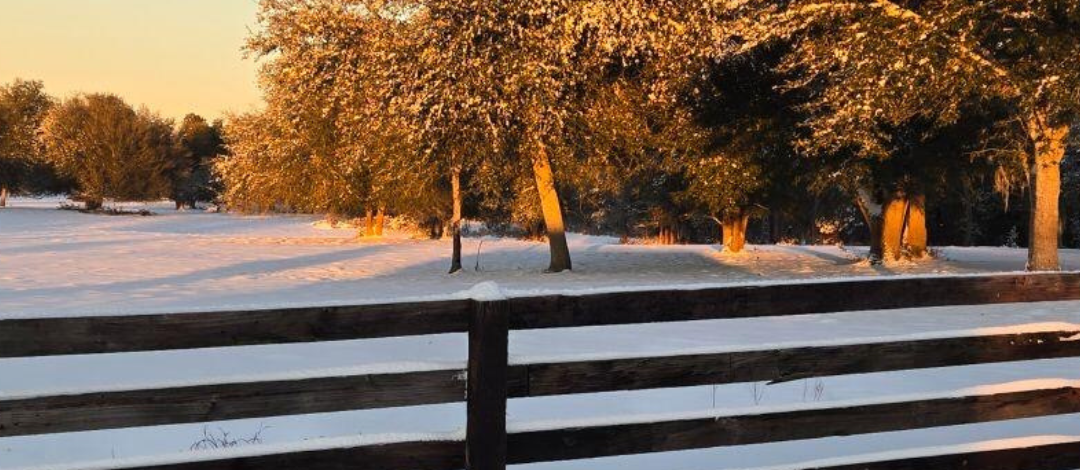
by Abbey Smith | Jan 24, 2025

Snowman in the Garden. Photo Credit: Abbey Smith, UF/IFAS Extension
2025 has already been a year for the books, as Winter Storm Enzo has proven that it really can snow in the Sunshine State. With the fluffy white snow also comes below freezing temperatures, therefore most landscape plants that fit the hardiness zones of Florida are not cold-tolerant or what is also called “cold-hardy.” In the Florida Panhandle, freezes are becoming more prevalent in recent years, so it is best to act ahead of time to protect your patio and landscape plants from feeling the adverse winter affects.
Preparation in Advance
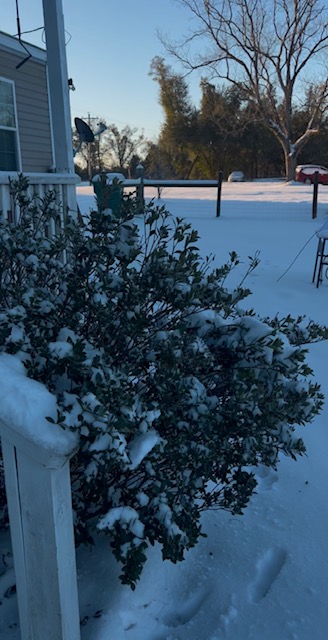
Gardenia bush in the snow. Photo Credit: Abbey Smith, UF/IFAS Extension Jackson County
It is always best to do your research and know what hardiness zone(s) your plants will thrive in. This will help you understand the level of cold tolerance the plant can withstand and will allow you to select cold tolerant varieties that will grow best in the Florida Panhandle. You can find your hardiness zone by using this link: https://planthardiness.ars.usda.gov/.
Proper care throughout the year will also help your patio and porch plants withstand freezing temperatures; a healthy plant has a better chance of recovering from cold damage than an unmaintained one. A freeze event can usually be spotted in the forecast multiple days in advance, and it is best to be proactive by moving potted plants that would be adversely affected to the indoors or to a warmer sheltered area.
Cold Protection Tips
One of the most effective ways to protect your plants from cold weather is covering them up during the night. Frost cloths can be purchased at most garden stores or through online platforms. If you are unable to buy frost cloths, you can use breathable materials such as old bed sheets or burlap bags that will still allow for air flow to the plant but keep it insulated and warm.

Example of frost cloth protection. Photo Credit: Molly Jameson, UF/IFAS Extension Leon County
You can also use mulch for insulation. Applying a thick layer of mulch around the base of your landscape plants will help insulate the soil to regulate ground temperatures and protect the plant’s root system from cold weather damage. Pine straw or leaves will work best and should be applied in a 3-to-4-inch layer kept away from the base of your stem or trunk of the plant. In some cases, it may be necessary to use an outdoor heat lamp, but always ensure that it is placed away from any flammable materials and only used as needed.
It has been said that using your irrigation at home can be a form of freeze protection. This is typically not effective for a homeowner. When farmers run irrigation to protect their crop, the irrigation systems that are used commercially are designed for scenarios like this. The irrigation must be run for several hours after temperatures rise for this method to work and protect the plants. With a home irrigation system, this is considered water-wasteful and the amount of water a home irrigation system emits can turn into heavy ice quickly, which will damage your plant rather than offer protection.
Cold protection for plants in Northwest Florida is all about preparation. Whether its covering plants, adding mulch to your landscape, or moving your plants indoors, a little effort can go a long way in preventing cold damage. With a bit of TLC, you can keep your landscape and garden beautiful all year long.
For more information please visit:
https://gardeningsolutions.ifas.ufl.edu/care/weather/treating-cold-damaged-plants/
https://gardeningsolutions.ifas.ufl.edu/lawns/maintenance-and-care/how-to-help-your-lawn-survive-the-chill/
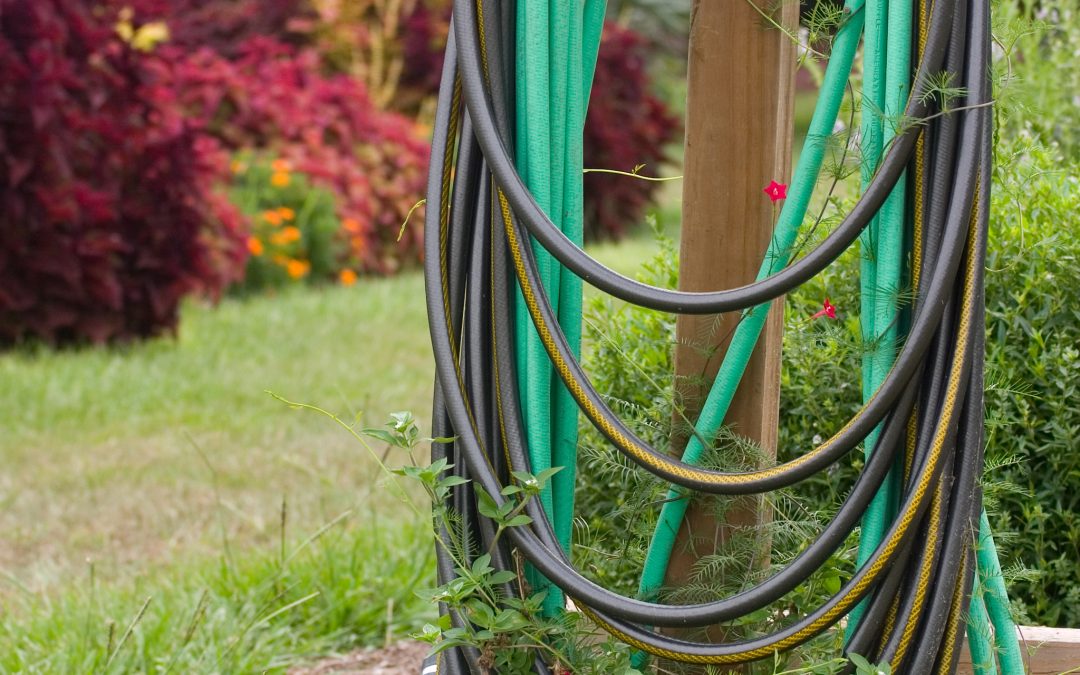
by Lauren Goldsby | Dec 13, 2024

UF/IFAS Photo by Tyler Jones
Many of us experienced our first freezing temperatures in the Panhandle last week. As we welcome winter, here are some helpful resources to prepare your plants when temperatures dip in the months ahead:
Frost in the Panhandle? Practical Tips for Protecting Your Garden
Cold Protection of Landscape Plants EDIS
One tip you’ll often see in these recommendations is to water your plants before a freeze. At first, this might seem counterintuitive, but wet soil can actually help your plants weather freezing temperatures for several reasons.
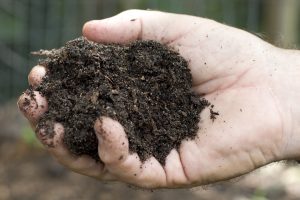
Soil naturally has small pockets of air. UF/IFAS Photography: Tyler Jones.
Water’s ability to absorb and hold heat—known as high specific heat—makes it a powerful tool against cold stress. Dry soil contains air spaces that don’t hold heat well. By watering your soil, you replace those air pockets with water, which absorbs more heat during the day and releases it slowly at night. This helps keep the soil and roots warmer than the surrounding air. Covering plants with sheets and frost cloth can help trap this warmth around the plants.

Dehydration from freeze damage can make leaf tissue look similar to drought stress. UF/IFAS Photo by Cat Wofford
Beyond heat retention, water also reduces the effects of cold stress. Both freezing and drought conditions cause plant cells to lose water, leading to dehydration. Water is essential for many plant functions including photosynthesis, nutrient transport, and maintaining structural support of the plant. Good water availability within the plant before the freeze helps reduce the water stress associated with cold damage. However, watering right after a freeze will not provide the same benefits because root activity slows in the cold weather.
For best results, water the soil in the morning before a freeze, focusing on the soil, rather than the leaves, as wet leaves are more prone to freeze damage. During fall and winter, plants generally require less frequent watering, so check the soil moisture before watering to avoid overwatering. Standing water can harm roots and increase stress on the plant.

Get familiar with your soil by checking moisture level before you water. UF/IFAS Photo by Tyler Jones
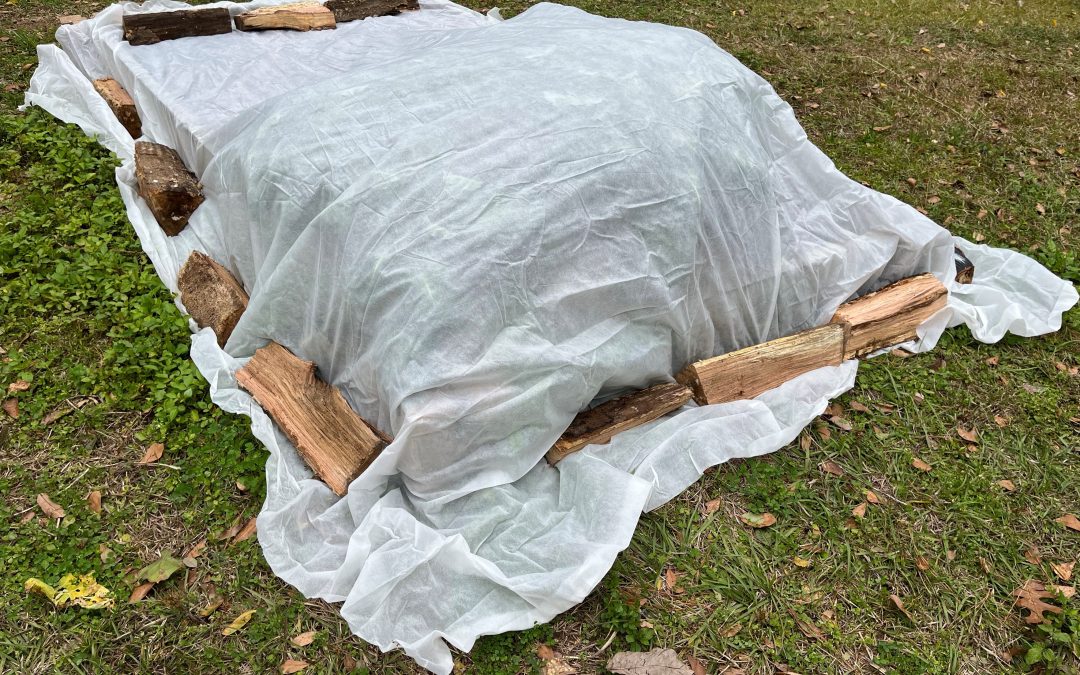
by Molly Jameson | Nov 6, 2024

Anchor frost cloth securely to keep it tightly in place, as removing air gaps helps trap ground heat and shield plants from cold air. Photo by Molly Jameson.
Here in North Florida, mild winters are the norm, but our occasional cold snaps can be enough to wreak havoc on our gardens. As you might remember, in December of 2022 the entire Panhandle experienced temperatures dipping into the teens and low 20s for several nights in a row, with some areas reaching as low as 18°F. This kind of unexpected freeze can catch even the most experienced gardeners off guard.
While plant covers are the go-to solution for many of us, pairing them with additional techniques can offer even better protection when temperatures dip. From common cold weather protection myths to practical DIY tips that enhance your plant cover’s effectiveness, knowing your options can make all the difference during an impending cold snap.
Cold Protection Myths and Misconceptions
When a frost or freeze warning hits, there’s plenty of advice flying around. Some of it’s helpful, and some, not so much. Here are a few misconceptions to clear up:

“Lollipop” trees will allow the heat from the ground to escape, giving the tree no cold protection. Photo by Jonathan Burns.
- “It’s All About Covering the Leaves”
Many gardeners believe that simply covering the leaves of their plants will provide adequate protection. However, this can lead to what’s commonly referred to as “lollipop” trees, where only the foliage is covered, leaving the trunk exposed. This is problematic because cold air can still penetrate, and the heat rising from the ground isn’t captured effectively. To ensure proper protection, the plant cover should touch the ground all around the plant to trap heat radiating from the soil, providing insulation from below. For best results, choose a medium-weight frost cloth (about 1 to 1.5 oz/yd²) made from breathable polypropylene or polyester fabric. These materials offer excellent insulation, providing about 4 to 8 degrees of temperature protection, depending on factors like cloth weight, ground heat trapped, and wind conditions. Frost cloth also allows moisture and air exchange, which helps prevent overheating on sunny days.
- “A Plastic Sheet Works Just as Well as Frost Cloth”
Throwing a plastic sheet over your plants might seem like an easy fix, but it often leads to more harm than good. Plastic is non-breathable, which can trap condensation and freeze on the plant’s surface. It also doesn’t insulate well, transferring cold temperatures directly to the leaves and stems. If you must use plastic in a pinch, make sure it doesn’t touch the plants directly and that it’s securely anchored to the ground to effectively trap warmth. Be sure to remove it in the morning once temperatures start to rise to avoid overheating.
- “Covering Your Plants Alone is Enough”

With PVC hoops ready to hold frost cloth and a thick layer of pine straw mulch, these raised beds are prepped for whatever winter throws their way. Photo by Molly Jameson.
While covering plants is crucial, sometimes additional steps can make a big difference. Mulching around the base of plants with a thick layer of pine straw or leaves helps insulate the soil and trap ground heat. It’s a small step that offers big protection to the roots and lower stems.
- “Watering Plants Before a Freeze Doesn’t Help”
Watering the soil around your plants before a freeze is a good practice because moist soil retains heat better than dry soil. This can help keep the root zone warmer overnight. However, it’s important to focus on watering the soil rather than the leaves. Water on foliage can freeze and cause damage, so it’s best to keep leaves dry as the temperatures drop. A deep watering a day or two before the cold hits is ideal for giving your plants a fighting chance.
DIY Cold Protection Solutions
If expensive greenhouses and plant covers are out of your budget or you want to get creative, there are plenty of do-it-yourself solutions for protecting your plants:
- Recycled Materials as Frost Protection
Old bedsheets, towels, or even buckets and cardboard boxes can be used in a pinch to cover smaller plants. Just be sure to anchor them down well, so they don’t blow away.
- DIY Hoop Houses

A temporary hoop house can be constructed using PVC pipes as the frame and polyethylene film as the covering to protect cold-sensitive plants during freezes. Photo by David W. Marshall.
For taller or sprawling plants, construct simple hoop houses using PVC piping with breathable frost cloth or lightweight plastic sheeting. Unlike placing plastic directly on plants, hoop houses create an air gap between the plastic and the plants, which helps trap heat from the soil while preventing direct contact damage. If using plastic, seal it tightly at night to trap warmth, and open it partially during the day to prevent overheating or excessive moisture buildup as temperatures rise. These low tunnels are perfect for garden beds or fruiting plants that need a little more room under cover.
- String Lights for Added Warmth
For extra protection, consider using outdoor-rated incandescent string lights (not LEDs, which don’t produce heat). Drape the lights around or near the plant under the covering to create a gentle source of warmth, which can raise temperatures by a few degrees on especially cold nights. For fire safety, keep lights from direct contact with dry materials and use only moisture-safe, outdoor lights.
- Windbreaks to Stop the Chill
In areas with open landscapes, cold winds can make frost damage even worse. Planting a hedge or using temporary barriers like hay bales or pallets can shield your garden from icy gusts and protect your more delicate plants.
Long-term Planning: Choose Cold-Tolerant Varieties
One of the best ways to prepare for cold snaps is to plant cold-tolerant varieties suited to North Florida’s climate. Vegetables like collards, kale, and carrots, or perennials like rosemary and garlic chives, can withstand mild freezes with little effort. If you’re growing fruit trees, look for varieties with proven cold tolerance or dwarf varieties that are easier to cover.
With a little planning and a few simple techniques, you can protect your garden from unexpected cold spells and keep it thriving through our chilliest nights.
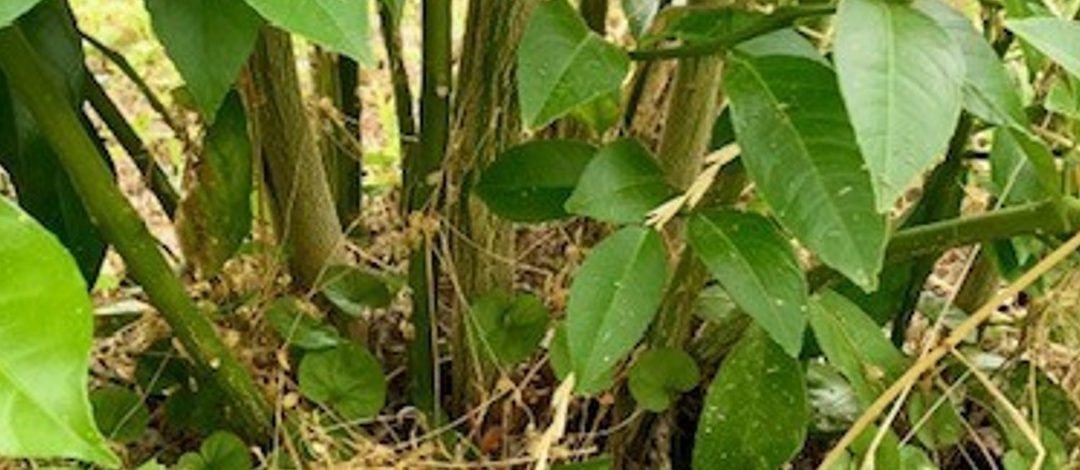
by Larry Williams | Jun 5, 2024
The widespread multiple night hard freeze that occurred in North Florida near the end of December 2022 resulted in numerous citrus trees becoming severely damaged. The above ground portion of many of these trees died as a result of the extreme cold.
I talked with numerous homeowners who were concerned about their citrus trees following that weather event. Many of these homeowners earnestly and hopefully watched for any sign of new growth on their cold injured citrus trees the following spring. When new growth appeared from the lower portion of the trunk and from the roots, the homeowner became excited with a false sense of hope that their citrus tree had survived and would again produce an abundance of desirable fruit.

Cold injured citrus tree with new growth coming from rootstock. Credit: Larry Williams
Now in the spring of 2024, many of these citrus trees have somewhat regrown from those root shoots, not from the completely dead tops. In most cases, the freeze damaged, dead tops of the once large trees have now been pruned away to allow the multitude of small diameter vigorous green shoots to grow.
Most purchased citrus trees are grafted. So, what survived and is now regrowing is coming from the rootstock, not from the original, desirable, edible fruit producing top. That desirable top was completely killed.
To better understand this scenario, perhaps a basic definition of grafting will help. This definition was taken from a University of Missouri Extension publication on grafting. “Grafting is the act of joining two plants together. The upper part of the graft (the scion) becomes the top of the plant, the lower portion (the understock) becomes the root system or part of the trunk.” Understock is also known as rootstock.
Grafting involves joining two different individuals. These individuals have to be closely related. For example, citrus can be grafted to other types of citrus and peaches can be grafted to other types of peaches. But citrus cannot be grafted to peaches.
The rootstock was selected because of some beneficial trait(s): resistant to a root pest, superior cold hardiness, imparts a dwarf growth habit to the top, etc. But the same rootstock produces undesirable fruit: bitter, hard, extremely seedy, etc. The top (scion) was selected because of a superior fruit: sweeter, bigger, more disease resistant, etc. But the same scion produces an inferior/weak root system. So, grafting the two together allows for the “best of both worlds.”
When all that is left is originating at or below the graft union or rootstock, the eventual resulting fruit will usually be undesirable, sometimes not edible.
So unfortunately, the best option in this scenario is to start over with another healthy grafted tree that is well suited for the potential cold weather of extreme North Florida.




















